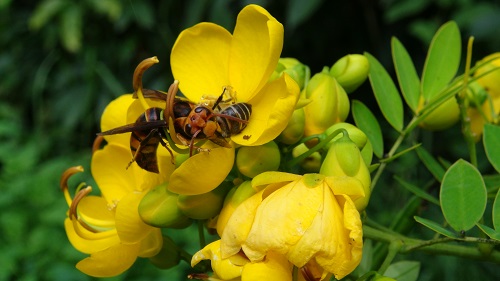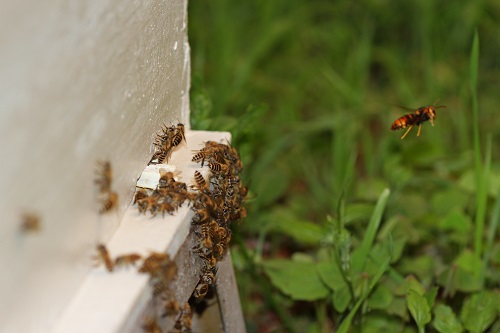Alarm communication is a key adaptation that helps social groups resist predation and rally defenses. The Asian honey bee species, Apis cerana, are attacked by formidable predators, giant hornets, at food sources and at their nests. Apis cerana is an excellent model for studying the effects of predator threats on colony signaling, because these bees require a coordinated defense against common hornet predator.
In cooperation with Prof. James C.Nieh from University of California, Prof. TAN Ken and his team of Xishuangbanna Tropical Botanical Garden (XTBG) observed how Asian honey bees were attached by hornets during foraging and at the nest. The researchers tested if workers would produce stop signals in both situations. They then hypothesized that predators posing a greater threat to individuals or the colony would elicit stop signals with graded changes in duration, frequency, or both.
The researchers tested the behavior of three A. cerana observation colonies by using tethered hornets to attack free-flying foragers trained to a rich sucrose solution feeder or bees at the nest entrance. They tested only one colony with one treatment at a time: large hornet, small hornet, or control. They also video recorded bee behaviors inside the nest and recorded bee sounds with a directional electret microphone.
The study showed that the Asian honey bee had evolved an alarm signal, the stop signal, which warned nestmates of danger. The stop signal consisted of a brief vibrational pulse that encoded information about the danger level in signal frequency and the danger context in signal duration. In the functionally referential alarm signal system, individual signals were altered according to danger context (pulse duration) and predator type (fundamental frequency).
When attacked by hornets, Asian honey bees significantly increased the production of a foraging-context stop signal that inhibited waggle dancing according to predator danger level. Attacks by hornets upon the nest entrance elicited distinctive stop signals that inhibited forager departure from the safe nest. When peer bees received signal, they would stop and escape danger.
The study provided the first evidence, in a social insect, of a functionally alarm signal and demonstrated a new level of sophistication in bee communication.
The study entitled “Honey Bee Inhibitory Signaling Is Tuned to Threat Severity and Can Act as a Colony Alarm Signal” has been published in PLoS Biology.
Contact
TAN Ken, Ph.D Principal Investigator
Key Laboratory of Tropical Forest Ecology, Xishuangbanna Tropical Botanical Garden, Chinese Academy of Sciences, Mengla, Yunnan 666303, China
Tel: 86-871-65227717
Fax: 86-871-65227358
E-mail: kentan@xtbg.ac.cn 
An individual honey bee responses to attack by hornet. (Image by TAN Ken) 
Large hornet attacks honeybees at the nest. (Image by TAN Ken) |


